Abstract
Wave energy is a kind of clean energy that is rich in reserves and has not been exploited on a large scale. The slope-pendulum wave energy conversion (S-PWEC) device has been optimized in structure and its capture efficiency has been increased. Taking the selection of the Zhejiang sea area as the research background, this paper performs numerical simulation and array WEC experimental testing of S-PWEC under 66 major sea conditions. The experimental results show that S-PWEC adds a slope structure to the bottom, which can effectively improve the motion response ability and resistance to extreme sea conditions. In the regular wave and irregular wave tests, the electron power output efficiency can be increased by 13.24% and 10.06%, respectively; in the array WEC experiment, the diffraction effect and radiation effect will affect the work of the array WEC, and the optimal arrangement distance can be selected to maximize the power output of the WEC system.
1. Introduction
Wave energy converters (WECs) are devices used to absorb energy in waves and convert the output into electrical energy. Although wave energy conversion projects have not fully reached the commercial stage, it is an ancient discipline, and hundreds of different forms of wave energy conversion device concepts and models have been proposed and experimented with over the past few hundred years [1,2,3,4].
There are many ways to classify wave energy conversion devices, which can be divided into onshore, nearshore, and offshore according to the installation location. The offshore WEC can be in a higher-energy wave environment, which is conducive to absorbing more wave energy, but it will bring great challenges to the structural stability, cost, installation, and maintenance of the device [5], which is unfavorable for the commercialization of wave energy conversion devices. Therefore, the WEC built onshore or nearshore does not need to arrange long submarine cables, manual maintenance is relatively easy, the cost is greatly reduced, and the long-term operation of the WEC can be achieved, which may be more attractive for commercial investment. How to develop a stable and efficient WEC is a very challenging research project.
Companies or research teams have developed several different modes of wave energy conversion devices near the shore and on land. The Oyster device developed by Queen’s University in the United Kingdom has been updated for two generations. It has performed well in various indicators and has successfully achieved long-term stable operation under real sea conditions [6]. Unlike Oyster, WaveRoller uses a fully immersed floating pendulum, which can form an array power generation module. All floating pendulum movements are completed under the water surface, and its power range is 350 kW-1000 kW [7]. Eco Wave Power combines a pendulum-type wave energy conversion device with a breakwater, and currently has more than 325.7 MW of important project pipelines worldwide [8]. Wavestar combines offshore wind energy capture devices to achieve multi-energy hybrid absorption and improve commercial competitiveness [9].
The main technologies for optimizing the WEC are physical experiments, numerical simulation, and real sea condition testing. With the development of modern computers, numerical simulation technology provides more space for optimization. Its advantage is that it is relatively convenient and fast, does not require the construction of physical objects, and the cost is low [10]. Poguluri et al. used CFD technology to test WEC-rotor, which can be well consistent with the results of physical experiments [11]. This article mainly focuses on a set of open-source programs developed by the WEC-Sim team to optimize the design of a new type of WEC. Ruehl et al. used WEC-Sim to make meaningful optimizations and designs of floating oscillating surge wave energy converters [12]. Wei et al. learned the feasibility of the multi-pump multi-piston power take-off system for the WEC [13], and Sricharan and Chandrasekaran used WEC-SIM and PTO-Sim to evaluate the output of a bean-shaped multi-body floating wave energy converter to maximize power [14].
Complex and changeable sea conditions, and the size and shape of the WEC will affect the work efficiency of the WEC. If the amplitude of WEC motion is increased while the original cost remains unchanged, wave energy capture and power output can be increased, which may be an effective method. The slope-pendulum wave energy conversion device designed in this paper is based on this concept. Through the reflection of waves under the free liquid level, the floating plate is subjected to greater wave excitation force, thereby increasing the incoming torque from the power take-off (PTO) to the hydraulic cylinder, and realizing the first-level wave energy capture efficiency improvement, and ultimately realizing the entire WEC device conversion efficiency improvement.
In short, the development and research of WECs are accelerating, and it is the goal of many researchers and countries interested in developing wave energy to design a WEC device that is suitable for real sea conditions and has a high yield. In this paper, the concept and model of a new wave energy conversion device are studied and developed under the conditions of Zhoushan, Zhejiang, China. In Section 2, this model concept is introduced and described in detail. Next, Section 3 defines and describes the steps and methods of this device experiment. Finally, meaningful results are obtained from these numerical simulation experiments, and discussions and research are carried out.
2. Mathematical
2.1. S-PWEC
To be able to maximize wave energy capture, Wan et al. [15] designed a slope-pendulum wave energy converter, as shown in Figure 1. The device consists of two main modules:

Figure 1.
Structure schematic of S-PWEC.
PTO Module: The part is mainly composed of a hydraulic system and generator, a floating plate under the action of wave excitation, and rotating movement around the fixed hinge pivot point, pushing the hydraulic rod. The hydraulic rod movement will compress the hydraulic cylinder and convert the mechanical energy of the floating plate into hydraulic energy. The hydraulic system is a hydraulic circuit consisting of a high-pressure accumulator (HPA), a low-pressure accumulator (LPA), and a check valve. Afterward, the hydraulic energy will be converted into electrical energy using a generator and stored in a battery, or the electricity can also be directly integrated into the grid system.
AAM Module: Different angular positions of the slope in the water have different effects on the reflection and transmission of the incident waves [16]. Under different sea conditions, the AAM system is used to adjust the position of the slope to make the best reflection of the incident waves, which allows the floating plate to absorb as much wave energy as possible to maximize the power output.
When the S-PWEC model does not have a slope structure, it is defined as NS-PWEC in this article.
2.2. Motion Response
Based on the Cummins time domain equation [17], and considering the floating plate viscous effect [12], the motion response equation of the floating plate to the pivot point can be obtained:
In the above equation:
- , , and are the angular displacement, angular velocity, and angular acceleration of the device moving at the pivot point, respectively.
- and are the moment of inertia of the device and the additional moment of inertia at infinite frequency, respectively.
- is the convolution term of the radiation moment, which represents the memory effect of the fluid, where is a small time step.
is radiation damping.
- and are the buoyancy moment and the gravitational moment, respectively, which constitute the recovery moment of the floating plate, which is .
- is the excitation moment; the excitation moment of the regular wave can be given by the following equation:where denotes taking the real part, denotes the moment per unit wave amplitude of the floating plate at frequency ω, and is used to avoid strong transient flow, which is expressed as:
is the computation time and is the continuous function computation time.
The excitation moment for the irregular wave case can be expressed as follows:
is for calculating the random wave spectrum under the sea state.
- is the secondary viscous drag moment; in practice, the wave energy converter device in the process of action with the wave will induce vortex detachment, resulting in a viscous effect [18].where is the coefficient of the secondary damping term in the viscous torque. can be obtained from the relevant literature or hydrodynamic experiments. V is the speed of the floating plate, is the speed of the surrounding fluid, and represents the moment of the viscous force on the pivot point.
- is the damping torque of the hydraulic power take-off.where is the pressure difference in the hydraulic rod, is the cross-sectional area of the hydraulic rod, and is the distance from the intersection of the hydraulic rod and the floating plate to the pivot point. Assuming that the hydraulic rod is always perpendicular to the floating plate, and the nonlinearity of the PTO is not considered, the influence of the nonlinear PTO on the wave energy capture efficiency will be studied in future work.
For measuring the merit of a wave energy conversion device, it is necessary to define the capture width ratio (CWR), the ratio of the average power absorbed by the device for the converted wave energy to the incident wave energy power per unit time [19]. In addition, this paper compares the electron power output efficiency (EPOE) of the device, which can be defined as the ratio of the electron power output of the WEC device to the incident wave power:
where is the device width, and are the primary wave energy capture efficiency and tertiary electrical output efficiency of the WEC per unit time, respectively, and is the incoming wave power per unit width of the incident wave.
3. Results and Discussion
The geometry files and hydrodynamic coefficients are imported in WEC-Sim (using boundary element software such as WAMIT, NEMOH, and ANSYS AQWA) and the motion response of the imported objects under different sea conditions is determined with the help of control equations, wave loads, and the PTO-Sim module [20], as shown in Figure 2.
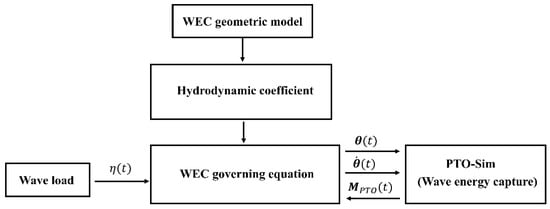
Figure 2.
Workflow diagram.
3.1. Initial Condition Setting
3.1.1. Analysis of Sea State Conditions
The wave period and wave height data from 1 January 2021 to 1 January 2022 in the sea area of Zhoushan, Zhejiang Province, China are obtained on NOAA, as shown in Figure 3. The statistical results show that the wave energy generated by waves with a spectral peak period of 6–9 s and a wave height between 0.5 and 2 m in the Zhoushan sea area accounts for about 60% of the annual wave energy, which is close to the research results of Wang et al. [21].
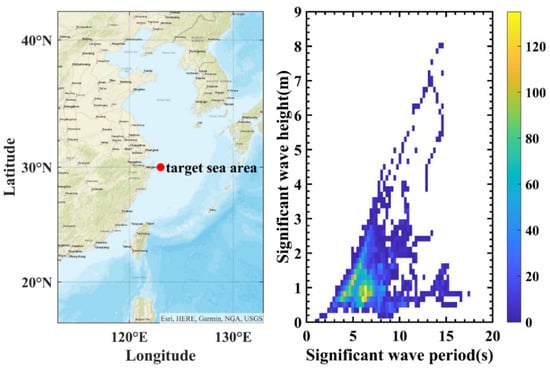
Figure 3.
Statistical of sea state.
3.1.2. Single WEC Model
The floating plate and the slope structure are used to obtain BEM hydrodynamic data in ANSYS AQWA, some of which are shown in Table 1. Meanwhile, a slope-pendulum wave energy conversion device model is established in MATLAB Simulink [22], and a hydraulic power take-off (PTO) is used for power generation to complete the conversion from wave energy capture to mechanical energy and finally realize the output result of electrical energy.

Table 1.
S-PWEC components parameters.
As shown in Figure 4, “plate” represents the main body of the floating plate and “Slope” represents the slope structure, both of which are constrained by “PTO” so that the floating plate can only rotate around the fixed axis. “PTO” transmits the wave energy captured by the floating plate to “PTO-Sim” as a moment, and calculates the power that can be obtained, which is the hydraulic force extractor chosen in this model. The device is fixed to the “global reference frame” through the “constraint”, which acts as the seabed in the model and is used for various data input in the simulation. The “PTO-Sim” works by transferring the torque at the connection point between the PTO and the floating plate, and converting the mechanical energy into the hydraulic system’s pressure energy to achieve a stable output of electricity. Some of the essential data for the WEC-Sim simulation are shown in Table 2.
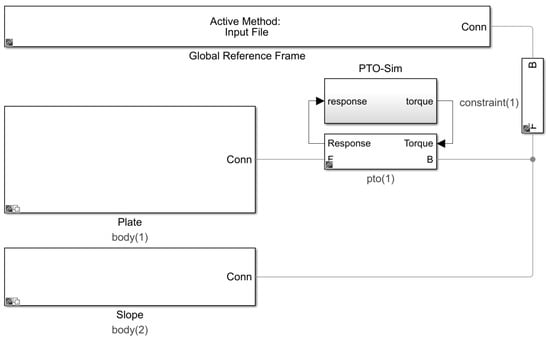
Figure 4.
Single WEC model.

Table 2.
WEC-Sim simulation parameters.
3.2. Motion Response
The new slope-pendulum wave energy conversion device fixes an adjustable angle slope structure in the lower part of the floating plate, the presence of which can be used for wave reflection and limit the angular displacement of the floating plate immersed in seawater; when it is under severe sea conditions; its maximum angular displacement is related to the angle of the slope.
As shown in Figure 5, when the floating plate works under a regular wave condition with a wave height of 2 m, the floating plate will not touch the slope structure and the overall operation is relatively continuous. However, when the wave height increases to 6 m, the amplitude of the floating plate increases accordingly, and the downward amplitude will exceed the initial displacement between it and the bottom slope (the angle between the floating plate and the slope in hydrostatic water); then, it will touch the bottom slope structure, and a small oscillation will occur, which is used to reduce the speed of the floating plate while waiting for the next wave peak to come. This process, which can only be triggered under larger sea conditions, is an effective self-locking protection mechanism that uses its own oscillations to consume excess energy, which is useful for trying to apply captured wave energy under extreme sea conditions (typhoon weather) and for maintaining the stability of its own system.
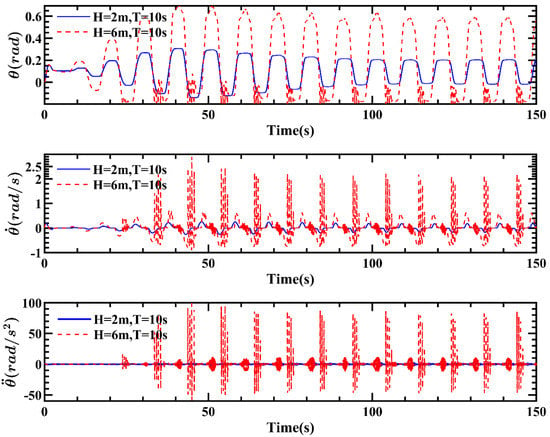
Figure 5.
Self-locking response of S-PWEC.
3.3. Power Generation Efficiency of Single WEC
In order to better illustrate that the bottom-inclined plate structure can reflect the wave energy under the free liquid surface and facilitate the absorption of the floating plate, it is necessary to compare the hydrodynamic response results and each power output result of S-PWEC and NS-PWEC. The initial conditions of the incident wave are: regular wave; wave height H = 2 m; period T = 6 s. The steady working phase t = 100–150 s is selected, and the hydrodynamic response results are shown in Figure 6. It can be clearly seen that the angular displacement amplitude of S-PWEC is larger compared with NS-PWEC, which is nearly doubled, indicating that the wave excitation force on the floating plate of the S-PWEC device is larger than that of the N-SPWEC device. The addition of the slope structure can significantly increase the motion amplitude of the device and provide positive feedback to the wave energy capture results, which can also be greatly enhanced.
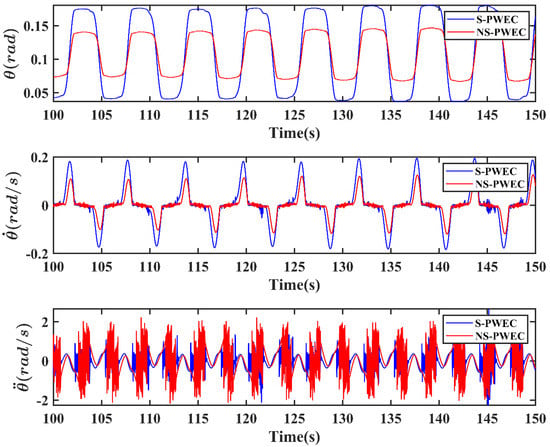
Figure 6.
Motion Response of S-PWEC and NS-PWEC.
The peak speed of S-PWEC is increased by 58.3%, which again shows that the motion of the floating plate is more violent and subject to the strong impact of waves, which is very meaningful for the design of the wave energy conversion device (provided that it is within the load-bearing range of the device), and by adding a slope structure at the bottom, the wave field energy reflection is concentrated near the free liquid surface, which increases the wave intensity near the floating plate and makes the floating plate as high as possible. It is an essential part of the commercialization to capture wave energy and improve the efficiency of wave energy capture to obtain more profit with small cost.
The output power of S-PWEC and NS-PWEC in each stage is shown in Figure 7. “Abspower” represents the power transferred from the floating plate to the hydraulic rod, which is the first-stage wave energy capture power; “genpower” is the power transferred from the hydraulic system to the generator; “elepower” is the final output power of the generator. It is known from Figure 6 that the addition of the slope structure at the bottom of the floating plate can effectively increase the motion response of the floating plate, the first-level hydrodynamic capture efficiency and power (despite the loss in the conversion of mechanical and electrical energy, the final converted electrical power must be increased), the wave energy first-level instantaneous capture power by 73.1%, and the final electrical output power by two times. This result is exciting, showing that a slope structure can at least have a favorable impact on the wave energy capture, and this optimization on the WEC structure is certain.
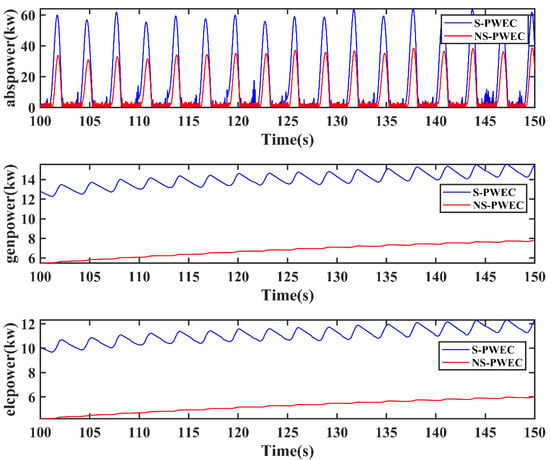
Figure 7.
Power output of S-PWEC and NS-PWEC.
In Section 3.1.1, the collation of the sea state is carried out, so the main sea state of the Zhoushan sea area is the condition for simulation experiments, and the range of the test sea state is shown in Table 3. After the free arrangement and combination, there is a total of 66 groups of sea state experiments, the experimental objects are S-PWEC and NS-PWEC, and the following will obtain the electron power output efficiency (EPOE) of S-PWEC and NS-PWEC in the form of a matrix, as shown in Figure 8 and Figure 9.

Table 3.
Study of sea state.
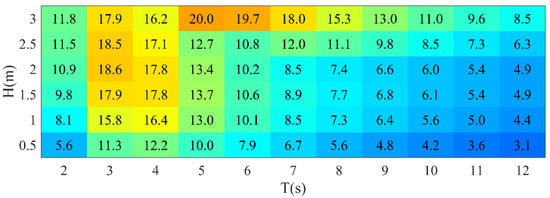
Figure 8.
NS-PWEC power generation efficiency under regular wave sea conditions.
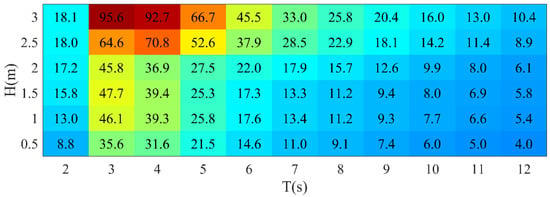
Figure 9.
S-PWEC power generation efficiency under regular wave sea conditions.
As shown in Figure 9, among 66 kinds of sea state tests, the optimal sea state for the NS-PWEC device is T = 5 s, H = 3 m sea state, and the power generation efficiency is 20%, which shows that the better power generation sea state for this wave energy conversion device is roughly concentrated in such a sea state with small period and large wave height.
As can be seen from Figure 9, for the S-PWEC device, the power output efficiency is greater than the NS-PWEC power output efficiency results in all of these 66 sets of sea state tests, once again indicating that the S-PWEC has a significant improvement in wave energy capture and absorption compared to the conventional NS-PWEC device. Its optimal sea state is at T = 3 s and H = 3 m, and the power output EPOE reaches 95.58%, which is an incredible power generation efficiency. For the 3D device, wave energy beyond its width is absorbed, resulting in a CWR greater than 100%, as has been confirmed by many researchers [23], but it is also sufficient to show that this sea state is particularly favorable for the new wave energy conversion device for power output. Of course, the high output efficiency of the S-PWEC is also due to the resonance of the SOFWEC device in this sea state, which means that the efficiency of the WEC is several times higher than usual if the WEC resonates with the surrounding wave field when capturing wave energy.
Obviously, the optimal capture sea state of the S-PWEC device calculated in this paper is not the highest-frequency sea state in the Zhoushan sea area, which means that S-PWEC still has room for optimization. From the above calculation results, it can be seen that the inherent period of S-PWEC is close to three seconds, which is consistent with the results of the free decay test. As shown in Figure 10, the subsequent optimization of the S-PWEC device will start from changing the inherent period of the device and adjusting the shape, density, and cavity volume of the floating plate to make its inherent period close to the wave period of the Zhoushan sea, to achieve high efficiency in capturing wave energy.
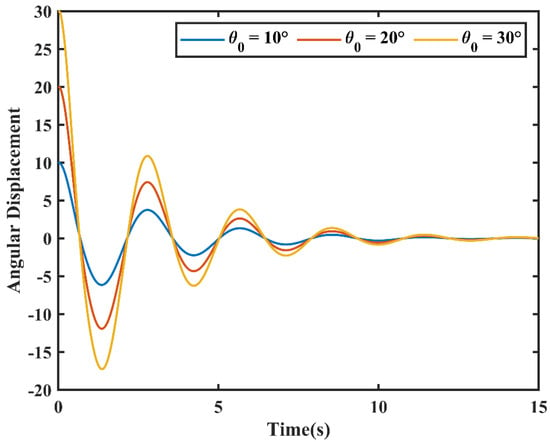
Figure 10.
S-PWEC free decay test.
The above-mentioned multiple sets of regular incident wave experiments can analyze some of the working characteristics of S-PWEC, but in the actual ocean, it can be regarded as a random wave sea condition formed by the random superposition of multiple regular incident waves. Therefore, it is very necessary to study the working characteristics of S-PWEC under random waves. Figure 11 and Figure 12 are the results of the power generation efficiency of the S-PWEC and NS-PWEC models under the random wave spectrum (Jonswap spectrum). Compared with regular wave sea conditions, the EPOE of both has been improved as a whole, but the power generation power has been significantly reduced. This is because the incident wave power under irregular wave sea conditions is also significantly reduced, and the captured wave energy is also reduced accordingly.
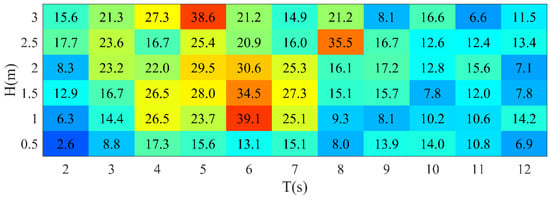
Figure 11.
Power generation efficiency of NS-PWEC under irregular wave sea conditions.
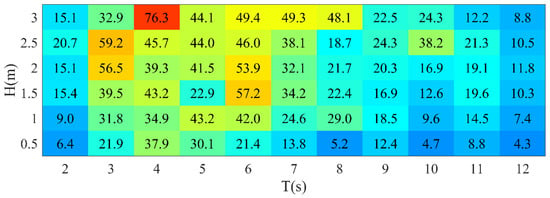
Figure 12.
Power generation efficiency of S-PWEC under irregular wave sea conditions.
The average power generation efficiency of NOSWEC and S-PWEC under regular and irregular wave sea conditions is shown in Table 4. From the results, adding a slope structure at the bottom of the floating plate can effectively improve its wave energy capture and absorption efficiency, which is meaningful for the development of wave energy conversion devices, which can exchange a smaller cost for a higher yield by adding a slope structure.

Table 4.
Average power generation efficiency.
3.4. Power Generation Efficiency of Array WEC
A single wave energy conversion device can only absorb limited energy. To realize the large-scale utilization and development of wave energy, it is necessary to study the arrangement of multiple wave energy devices. As shown in Figure 13, the S-PWEC is arranged in the direction of wave propagation, and then on the basis of WEC-Sim, a set of arrays of S-PWEC numerical models arranged along the direction of the incident wave are developed, as shown in Figure 14. Each floating plate works independently and is interrelated. In a single floating plate model, the effect of waves on the structure is mainly considered. However, in the array model, the diffraction effects and radiation effects of adjacent floats also need to be considered. These will change the local wave field, thereby affecting the WEC’s capture and absorption of wave energy. Finally, the output electrical energy of each independent WEC is incorporated into the power grid or stored in the battery.
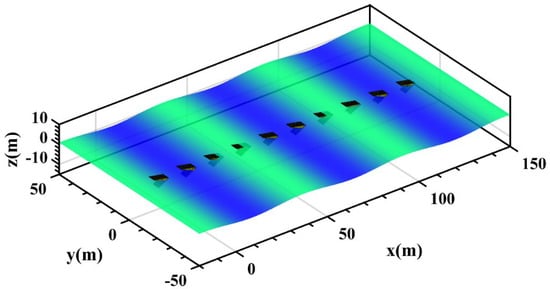
Figure 13.
Array S-PWEC model layout diagram.

Figure 14.
Array S-PWEC numerical model.
In the array WEC experiment, the incident waves pass through each floating plate in sequence, and ten identical wave energy conversion devices are arranged at the same distance. Starting from the pivot point of the first S-PWEC, the distance between the hinge points of two adjacent WECs is defined as . The interaction between waves and floating plates can be treated by ANSYS AQWA, and many hydrodynamic coefficients can be obtained.
When the interval distance of the new wave energy conversion device = 15 m, and the sea condition is set as a regular wave with T = 6 s and H = 2 m, the PTO-Sim module can calculate the power output of 10 different floating plates. As shown in Figure 15, the output power of the first floating plates is highest, which is 6.9 kW, and the power generation efficiency is 15.39%. The latter floating plates are reduced in different degrees. It is not difficult to understand that this is because every time an incident wave passes a floating plate, part of the energy carried by it will be absorbed. The energy absorbed by each S-PWEC is related to the change in local wave field, and the distance between adjacent S-PWECs must be considered.
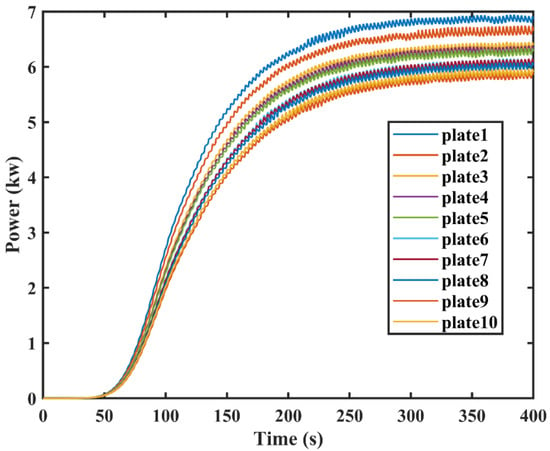
Figure 15.
Power output power of the array S-PWEC.
From the above analysis and discussion, it is known that the distance between the floating plates of the S-PWEC array will directly affect the efficiency of the floating plates in absorbing and capturing wave energy. This time, the control variable experimental analysis of the floating plate distance along the wave direction was carried out. Under the sea conditions with a period of T = 6 s and a wave height of H = 2 m, the numerical calculation was used to obtain the results shown in Figure 16.
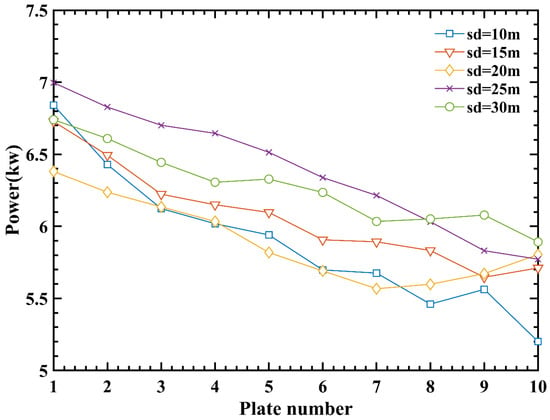
Figure 16.
Effect of different spacing on array S-PWEC power.
As shown in Figure 16, the electrical output power of the floating plate at different spacing is different. In the WEC system with a spacing of 10 m, the electrical output power of the floating plate of different serial numbers changes significantly, showing that under small spacing, the hydrodynamic interaction of the adjacent WEC has a greater impact, and the overall absorption power will decrease. The spacing distance is too close to be conducive to wave energy capture, and the arrangement distance needs to be increased. When the spacing increases, the hydrodynamic interaction of the adjacent WEC weakens and the absorbed power rises. However, if the floating plate has a beneficial interaction with the adjacent floating plate in this process, the overall power will increase significantly. From the results, it can be found that the best power generation effect is the working condition of the array floating plate with a spacing of 25 m. The beneficial interaction of the adjacent floating plates increases the absorbed power. Under the prescribed sea conditions, it is a very good arrangement distance. The power generation power of the floating plate serial number 1–7 is significantly better than those of other working conditions, and the total power generation power of the ten floating plates reaches 63.87 kW. In addition, if the distance is too far apart, the number of wave-farm WECs in the same area will be reduced, and the utilization rate of the sea area will be low, which is not conducive to the absorption and utilization of wave energy.
4. Conclusions and Future Work
In this paper, the hydrodynamic performance and electric power output of a new wave energy conversion device are investigated using an open-source program to establish a numerical model, and the following conclusions can be drawn.
- The slope-pendulum wave energy conversion device adds a slope structure at the bottom to reflect through waves. The innovation of this structure can effectively enhance the ability of the floating plate to capture wave energy and improve the overall efficiency at a smaller cost.
- It can also cope with extreme sea conditions with large wave heights and has a certain “self-locking” function to keep the floating plate working normally, and the power generation efficiency of the wave energy conversion device is effectively improved under regular and irregular wave sea conditions.
- The array floating plate has a longitudinal optimal arrangement distance, the spacing is too large or too small, and it is not conducive to the array floating plate power generation. By experimental calculation, when the arrangement distance is 25 m, the whole wave energy conversion system electrical energy output power reaches the maximum.
In the current work, the wave energy capture efficiency has been improved through the optimization of the structure. In the future work, the angle of the bottom oblique plate structure will continue to be studied, the optimal angle under different sea conditions will be given, and the other arrangement of the array floating plate will be studied, and we will focus on optimizing the design and active control to improve the overall wave energy absorption capacity.
Author Contributions
Z.W., conceptualization, methodology, analysis; Z.L., data curation, analysis, writing—original draft, writing—review and editing; D.Z., conceptualization, methodology, writing—review and editing, supervision; H.Z., software, data curation, analysis, writing—original draft. All authors have read and agreed to the published version of the manuscript.
Funding
The support by the National Natural Science Foundation of China (Nos. 11572283; 11602179), the National Key Research & Development Plan of China (Nos. 2017YFC1403306; 2016YFC1401603); the Program for Zhejiang Leading Team of S & T Innovation (No. 2010R50036); the Public Science Technology Research Funds Projects of Ocean (No. 20110518-5) and HPC Center OF ZJU (ZHOUSHAN CAMPUS) are all gratefully acknowledged.
Institutional Review Board Statement
Not applicable.
Informed Consent Statement
Not applicable.
Data Availability Statement
Data available on request due to restrictions of privacy.
Conflicts of Interest
The authors declare no conflict of interest.
References
- Ahamed, R.; McKee, K.; Howard, I. Advancements of Wave Energy Converters Based on Power Take off (PTO) Systems: A Review. Ocean Eng. 2020, 204, 107248. [Google Scholar] [CrossRef]
- Guo, B.; Ringwood, J.V. Geometric Optimisation of Wave Energy Conversion Devices: A Survey. Appl. Energy 2021, 297, 117100. [Google Scholar] [CrossRef]
- Rusu, E.; Onea, F. A Review of the Technologies for Wave Energy Extraction. Clean Energy 2018, 2, 10–19. [Google Scholar] [CrossRef]
- Titah-Benbouzid, H.; Benbouzid, M. An Up-to-Date Technologies Review and Evaluation of Wave Energy Converters. Int. Rev. Electr. Eng. IREE 2015, 10, 52–61. [Google Scholar] [CrossRef]
- López, I.; Andreu, J.; Ceballos, S.; Martínez de Alegría, I.; Kortabarria, I. Review of Wave Energy Technologies and the Necessary Power-Equipment. Renew. Sustain. Energy Rev. 2013, 27, 413–434. [Google Scholar] [CrossRef]
- Whittaker, T.; Folley, M. Nearshore Oscillating Wave Surge Converters and the Development of Oyster. Philos. Trans. R. Soc. Math. Phys. Eng. Sci. 2012, 370, 345–364. [Google Scholar] [CrossRef] [PubMed]
- Waveroller. Available online: https://aw-energy.com/waveroller/ (accessed on 7 September 2022).
- Tul Huda Ahmad, N.H.; Zamri Ibrahim, M.; Rahman, S.J.A.; Albani, A.; Mohad, S. The Development of Wave Energy Converter System Using Hydraulic Power Take Off at Terengganu Shoreline. In Proceedings of the 2018 International Conference and Utility Exhibition on Green Energy for Sustainable Development (ICUE), Phuket, Thailand, 24–26 October 2018; IEEE: New York, NY, USA, 2018; pp. 1–7. [Google Scholar]
- Ghafari, H.R.; Ghassemi, H.; Neisi, A. Power Matrix and Dynamic Response of the Hybrid Wavestar-DeepCwind Platform under Different Diameters and Regular Wave Conditions. Ocean Eng. 2022, 247, 110734. [Google Scholar] [CrossRef]
- Ransley, E.J.; Greaves, D.M.; Raby, A.; Simmonds, D.; Jakobsen, M.M.; Kramer, M. RANS-VOF Modelling of the Wavestar Point Absorber. Renew. Energy 2017, 109, 49–65. [Google Scholar] [CrossRef]
- Poguluri, S.K.; Kim, D.; Bae, Y.H. Performance Assessment of Pitch-Type Wave Energy Converter in Irregular Wave Conditions on the Basis of Numerical Investigation. Ocean Syst. Eng. 2022, 12, 23–38. [Google Scholar]
- Ruehl, K.; Forbush, D.D.; Yu, Y.-H.; Tom, N. Experimental and Numerical Comparisons of a Dual-Flap Floating Oscillating Surge Wave Energy Converter in Regular Waves. Ocean Eng. 2020, 196, 106575. [Google Scholar] [CrossRef]
- Wei, Y.; Barradas-Berglind, J.J.; van Rooij, M.; Prins, W.A.; Jayawardhana, B.; Vakis, A.I. Investigating the Adaptability of the Multi-Pump Multi-Piston Power Take-off System for a Novel Wave Energy Converter. Renew. Energy 2017, 111, 598–610. [Google Scholar] [CrossRef]
- Sricharan, V.V.S.; Chandrasekaran, S. Time-Domain Analysis of a Bean-Shaped Multi-Body Floating Wave Energy Converter with a Hydraulic Power Take-off Using WEC-Sim. Energy 2021, 223, 119985. [Google Scholar] [CrossRef]
- Wan, Z.; Zheng, H.; Sun, K.; Zhang, D.; Yao, Z.; Song, T. Simulation of Wave Energy Converter with Designed Pendulor-Slope Combination. Energy Procedia 2019, 158, 733–737. [Google Scholar] [CrossRef]
- Midya, C.; Kanoria, M.; Mandal, B.N. Scattering of Water Waves by Inclined Thin Plate Submerged in Finite-Depth Water. Arch. Appl. Mech. 2001, 71, 827–840. [Google Scholar] [CrossRef]
- Cummins, W.E. The Impulse Response Function and Ship Motions. Schiffstechnik 1962, 47, 101–109. [Google Scholar]
- Giorgi, G.; Ringwood, J.V. Comparing Nonlinear Hydrodynamic Forces in Heaving Point Absorbers and Oscillating Wave Surge Converters. J. Ocean Eng. Mar. Energy 2018, 4, 25–35. [Google Scholar] [CrossRef]
- Babarit, A. A Database of Capture Width Ratio of Wave Energy Converters. Renew. Energy 2015, 80, 610–628. [Google Scholar] [CrossRef]
- Yu, Y.-H.; Jenne, D. Analysis of a Wave-Powered, Reverse-Osmosis System and Its Economic Availability in the United States. In Proceedings of the International Conference on Offshore Mechanics and Arctic Engineering, Trondheim, Norway, 25 June 2017; American Society of Mechanical Engineers: New York, NY, USA; p. V010T09A032. [Google Scholar]
- Wang, L.; Tang, X.; Xia, Y.; Liu, H. Assessment of Wave Energy Resources in Zhoushan Islands. Renew. Energy 2014, 32, 1939–1944. [Google Scholar]
- Simulink Documentation—MathWorks. Available online: https://ww2.mathworks.cn/help/simulink/index.html (accessed on 8 September 2022).
- Retzler, C. Measurements of the Slow Drift Dynamics of a Model Pelamis Wave Energy Converter. Renew. Energy 2006, 31, 257–269. [Google Scholar] [CrossRef]
Publisher’s Note: MDPI stays neutral with regard to jurisdictional claims in published maps and institutional affiliations. |
© 2022 by the authors. Licensee MDPI, Basel, Switzerland. This article is an open access article distributed under the terms and conditions of the Creative Commons Attribution (CC BY) license (https://creativecommons.org/licenses/by/4.0/).